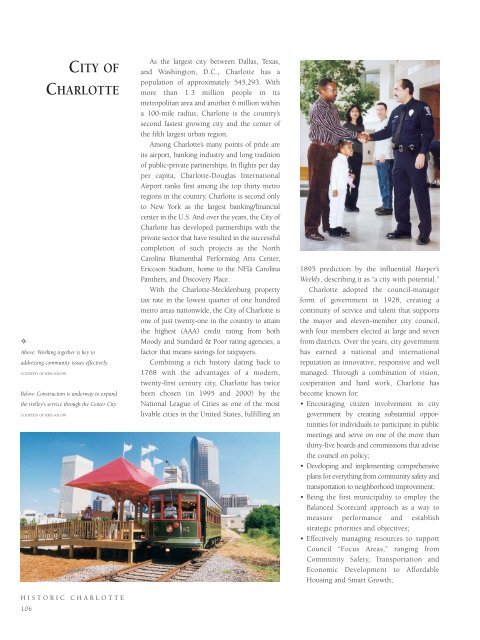Historic Charlotte
An illustrated history of the City of Charlotte and the Mecklenburg County area, paired with the histories of companies, families and organizations that make the region great.
An illustrated history of the City of Charlotte and the Mecklenburg County area, paired with the histories of companies, families and organizations that make the region great.
You also want an ePaper? Increase the reach of your titles
YUMPU automatically turns print PDFs into web optimized ePapers that Google loves.
✧<br />
Above: Working together is key to<br />
addressing community issues effectively.<br />
COURTESY OF KRIS SOLOW.<br />
Below: Construction is underway to expand<br />
the trolley’s service through the Center City.<br />
COURTESY OF KRIS SOLOW.<br />
CITY OF<br />
CHARLOTTE<br />
HISTORIC CHARLOTTE<br />
106<br />
As the largest city between Dallas, Texas,<br />
and Washington, D.C., <strong>Charlotte</strong> has a<br />
population of approximately 545,293. With<br />
more than 1.3 million people in its<br />
metropolitan area and another 6 million within<br />
a 100-mile radius, <strong>Charlotte</strong> is the country’s<br />
second fastest growing city and the center of<br />
the fifth largest urban region.<br />
Among <strong>Charlotte</strong>’s many points of pride are<br />
its airport, banking industry and long tradition<br />
of public-private partnerships. In flights per day<br />
per capita, <strong>Charlotte</strong>-Douglas International<br />
Airport ranks first among the top thirty metro<br />
regions in the country. <strong>Charlotte</strong> is second only<br />
to New York as the largest banking/financial<br />
center in the U.S. And over the years, the City of<br />
<strong>Charlotte</strong> has developed partnerships with the<br />
private sector that have resulted in the successful<br />
completion of such projects as the North<br />
Carolina Blumenthal Performing Arts Center,<br />
Ericcson Stadium, home to the NFL’s Carolina<br />
Panthers, and Discovery Place.<br />
With the <strong>Charlotte</strong>-Mecklenburg property<br />
tax rate in the lowest quarter of one hundred<br />
metro areas nationwide, the City of <strong>Charlotte</strong> is<br />
one of just twenty-one in the country to attain<br />
the highest (AAA) credit rating from both<br />
Moody and Standard & Poor rating agencies, a<br />
factor that means savings for taxpayers.<br />
Combining a rich history dating back to<br />
1768 with the advantages of a modern,<br />
twenty-first century city, <strong>Charlotte</strong> has twice<br />
been chosen (in 1995 and 2000) by the<br />
National League of Cities as one of the most<br />
livable cities in the United States, fulfilling an<br />
1895 prediction by the influential Harper’s<br />
Weekly, describing it as “a city with potential.”<br />
<strong>Charlotte</strong> adopted the council-manager<br />
form of government in 1928, creating a<br />
continuity of service and talent that supports<br />
the mayor and eleven-member city council,<br />
with four members elected at large and seven<br />
from districts. Over the years, city government<br />
has earned a national and international<br />
reputation as innovative, responsive and well<br />
managed. Through a combination of vision,<br />
cooperation and hard work, <strong>Charlotte</strong> has<br />
become known for:<br />
• Encouraging citizen involvement in city<br />
government by creating substantial opportunities<br />
for individuals to participate in public<br />
meetings and serve on one of the more than<br />
thirty-five boards and commissions that advise<br />
the council on policy;<br />
• Developing and implementing comprehensive<br />
plans for everything from community safety and<br />
transportation to neighborhood improvement;<br />
• Being the first municipality to employ the<br />
Balanced Scorecard approach as a way to<br />
measure performance and establish<br />
strategic priorities and objectives;<br />
• Effectively managing resources to support<br />
Council “Focus Areas,” ranging from<br />
Community Safety, Transportation and<br />
Economic Development to Affordable<br />
Housing and Smart Growth;
















